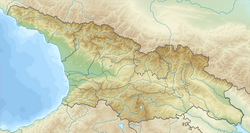Gudamakari
Gudamaqari
Historical region in Mtskheta-Mtianeti, Georgia
Gudamaq'ari (Gudamakari;[1] Georgian: გუდამაყარი) is a small historical geographic area in northeast Georgia on the southern slopes of the Greater Caucasus Mountains. Located along the river valley of Aragvi, it is bordered by Mtiuleti on the west, Khevi on the north, Khevsureti and Pshavi on the east, and Khando and Ch'artali communities on the south. Gudamaq'ari is sometimes viewed as a part of Mtiuleti. Modern administrative subdivision of Georgia places the area in the Mtskheta-Mtianeti mkhare (region).
You can help expand this article with text translated from the corresponding article in Georgian. (March 2014) Click [show] for important translation instructions.
|



